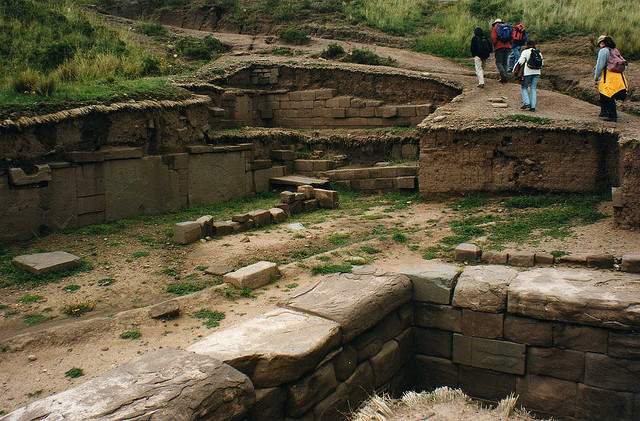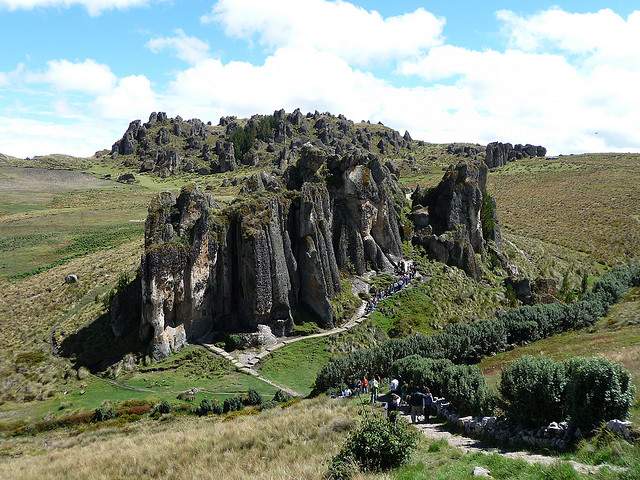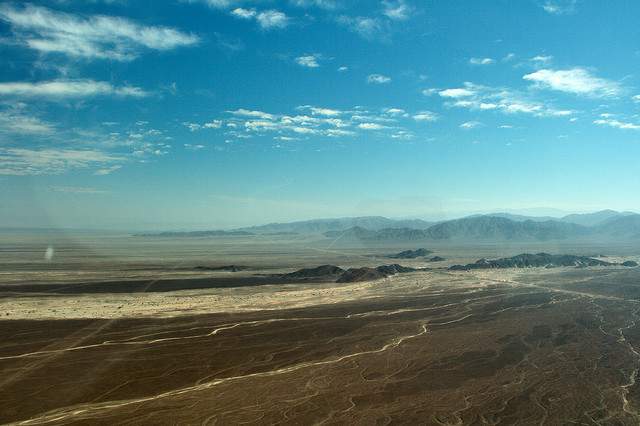Some ancient ruins baffle scientists. Peru is full of them. For years scholars have excavated archaeological sites in the Andes regions until their spades are blunt and their heads are sore. Enigmas like the Nazca Lines and Tiwanaku have become such an obsession for researchers they have dedicated the greater part of their careers to them, and in doing so raised more questions than they found answers. But these same anomalies and unanswered questions also attract the attention of the passing observer. The next time you’re trekking through the Andes why don’t you check in and see if you can find any missing clues.
Tiwanaku
Perhaps the biggest enigma of them all is Tiwanaku in northern Bolivia, 75km (45 miles) west of La Paz. Before it was mysteriously abandoned the city that was home to over 100,000 residents. Then the Spanish arrived and left in tatters. Although the broken stones strewn across the settlement don’t make for archaeological eye-candy, the story behind the precision-cut stones is arguably more fascinating than the Pyramids of Giza, the Mayan Temples and its Andean counter-part, Machu Picchu. Evidence of space-age technology is like something straight from Stargate and has led some researchers to speculate the architectural knowledge was given to our ancestors by extra-terrestrials.
Tiwanaku poses a major problem for archaeologists and historians. The advanced engineering found at the settlement is difficult to replicate today and continues to baffle researchers. Mainstream archaeologists date the ruins back to around 500 AD, but alternative theories proposed by renegade scholars suggest it could have been built as far back as 15,000 BCE. The site is in the process of a re-build, but work on the Akapana Pyramid was abruptly stopped by UNESCO as they argue the adobe bricks the Bolivian government are using to rebuild the 60m structure with will not restore it to its original state.
To get the most from your visit to Tiwanaku take a guided tour with one of the tour operators in La Paz. A good guide will know the history of the site together with the theories that make the attraction such a fascinating place to visit. The two hour drive into the mountain leaves around 8.30 in the morning and the 80 soles (US$30) fee includes lunch and entrance into two museums and the ruins.
Amaru Muru – Puerta de Hayu Marka
One of the strangest attractions in Peru is Puerta de Hayu Marka, located near Lake Titicaca, 35km from Puno. The bizarre-looking rock formation of this ancient site is not the strangest thing visitors will find here – that is the reserved for a random doorway cut into the side of the rock, dubbed by the locals as the “Gateway of the Gods.”
The site is commonly referred to as Amaru Muru, so called after the Inca priest who, according to legend, passed through the portal into another dimension. Locals say people have gone missing near the rock and are afraid to go to the site. The area has also been known to emanate a strange blue glow. There are many tour operators offering trips to Amaru Muru from Puno. You can take a personal guide and also visit the temple of fertility in Chuquito, but for a truly unique experience organise a trip with Shamans who perform a ritual and make offerings to Pachamama (Mother Earth.)
Cumbe Mayo
A thirty minute drive up in to the hills from Cajamarca is yet another strange discovery in Peru. Cut into the rocks are 9km of man-made canals believed to have been dug around 1500 BCE. What is strange about these canals are the sides are precision cut to 90 degree angles and at points drive straight through the stone hills. Visitors will also find strange petroglyphs carved into the side of a rock near the entrance. To date nobody has been able to decipher what the images mean. The site is a complete mystery.
Part of the ambiguity about Cumbe Mayo is that no one can understand why the channels, used for irrigation purposes, were cut to such precision. Then there is the question of how they were cut. Today it would take lasers to achieve that degree of accuracy. To add to the mystique of the place, creeping between the forest of craggy rocks, a low mist shrouds the area in a fantasy-world of fog. There are several tour operators around the Plaza de Armas running trips to Cumbe Mayo twice a day. The guided tours take around two hours and lead you through beautiful hillside scenery and a tunnel cut through a massive rock.
Markahuasi
Situated 400km north of Lima, Markahuasi is yet another strange rock formation scholars cannot quite understand. Labelled as the “Playground of the Gods” the hilltop site provides stunning views of the surrounding mountains and features dozens of rocks that appear to have been carved into the shape of faces, snakes, fish and dragons. Some people say they are natural rock formations, but when you visit the site you will find that hard to believe. The question is though, why are they there?
The ruins at the summit indicate the site was occupied by the Inca at some point, though it is said the rock carvings existed a long time before they ruled the Andean region. There is an immense energy that emanates from the rocks and locals say Markahuasi was once used as a UFO landing site.
To get to Markahuasi from Lima, you need to take a collectivo to Chosica then a bus to San Pedro de Casta. There are only two busses a day to San Pedro so you will have to stay overnight. If you speak Spanish you may want to hire a local guide who will tell you many fascinating story’s, not all of which are believable (see above), but are worth hearing anyway.
Nasca Lines
The Nazca Lines are perhaps one of the most famous archaeological anomalies to be explored in Peru. They consist of a series of geoglyps etched into the dry desert sands in the south-west coastal region of Nazca, believed to have been put there by our ancient ancestors around 1400 years ago. The scientific community are baffled as to what purpose the images served.
Theories again point towards our ancient ancestors trying to communicate with aliens, though the markings don’t relate to anything alien like, but are in fact archetypes that were central to ancient cultures such as the condor, the humming bird, monkey and parrot. The orthodox view is that they are roads, but the fact that the lines don’t lead to anywhere leaves these flimsy views open to interpretation.
The Nazca Lines are best viewed from the air and there are several tour companies operating flights in four to six man Cessna light-aircraft. Because of their popularity with tourist you are advised to book a week or two in advance of your arrival in Nazca, otherwise you could be hanging round for days on end waiting for a vacancy.
Caral
If there is a contentious discovery that has forced scholars to rethink their lectures and change the history books, it is Caral. Up until the discovery of the 5000 year-old pyramids in the foothills of Supe, it was believed that the earliest civilisation in the Andes region was the Chavin culture that date back to 900BCE. Caral is therefore somewhat of a groundbreaking discovery.
As part of a massive rehabilitation program, the settlement of five pyramids are being restored to their original condition and the site is being geared towards tourism with the inception of a restaurant, gift shop and tourist information centre. It currently doesn’t receive many visitors and those that do must be accompanied by a guide as a safety precaution. For a unique experience hire a horse.
Once the site is restored, Caral could be as big an attraction as Machu Picchu so you should go and see it before it gets too crowded, though perhaps when it is in a more advanced state of restoration than it is in 2011. To get there take a bus from Lima to Barranca. You will need to stay overnight in either Barranca or Supe then take a collectivo to Caral.
Check out these tips for having an indie travel experience in Lima.


